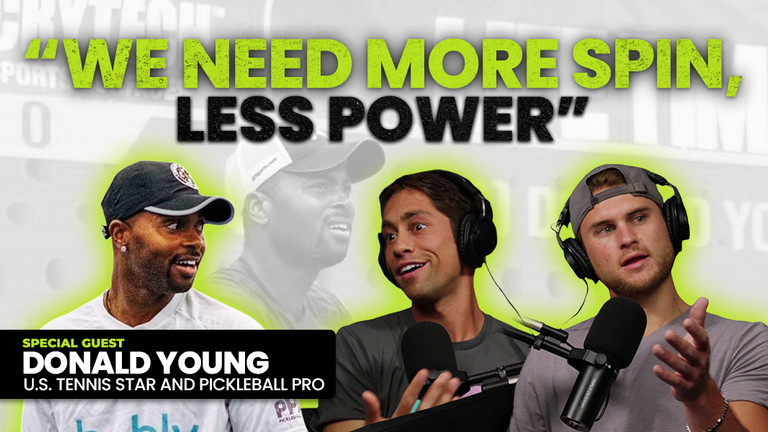
We're excited to tell you that Ben Johns, one of the most recognizable names in pro pickleball, recently agreed to join us on PicklePod (our podcast which you can listen to/watch here). That episode will be out later this week, but in the meantime, he's graced us with a note about PaddleGate 2023.
We leave you with his words below:
Here is a written version of what I recently spoke about on The Dink's podcast. As I think this is important for people to understand and more eloquently written than spoken.
TLDR summary at the bottom.
Pickleball paddle delamination
A lot of people think this issue is about limiting paddle technology improvements.
Understand this: if you want to have a conversation about whether to expand the power rules for paddles, that certainly can be done. That is not what this issue is about.
This issue is about the intention of the power test essentially being bypassed. And I’ll explain that below.
The best way I can explain what’s currently happening is to give you an analogy in Major League Baseball terms:
The MLB does not go “oh it passed when new, that bat is still good!”
The MLB rules say that all bats can be confiscated at any time by an umpire to go back to testing. A bat that displays the above characteristics would fail.
In pickleball terms, is paddle technology “improving” if a paddle is made such that it passes when new, but the first surface layer wears away quickly after use and beneath lies a table tennis-esq rubber?
The current scenario is that a “delaminated” paddle will pass the deflection test brand new, its core will break down via use, the core separates from the surface, the surface then has additional room to deflect, rebound, impart energy, and create a “trampoline” effect.
Related: New Paddle Challenge Policies Issued for US Open
The intent of the rules is clear. You pass the spin and power tests brand new, and after that performance characteristics should only decrease, not increase.
However, the rules, and especially the testing, for power after a paddle is used is currently a bit hazy.
To explain that a bit, you need to know more about the current test, deflection.
Pickleball paddle deflection
Deflection is related to power but doesn’t directly measure it.
These factors are definitely correlate to power, but they aren't the same thing.
Basically, when something is stiff and doesn’t deflect very much, the surface doesn’t have a lot of “room” to rebound and therefore doesn’t impart very much energy into the subject.
A good example is rubber: very flexible, not stiff, great energy transfer, very little energy lost upon rebounding.
Picture a rubber band: when you snap it, it goes back to its initial shape - we call that very elastic. It imparted nearly all of its given energy back.
However, let me give you an example of where the test doesn’t really apply: silly putty. It’s very deformable, it will deflect very much, but it’s almost entirely inelastic. It’s not going to snap back into shape at all or impart much energy.
So you can see, deflection is not a perfect test for power by any means.
That’s why deflection is not an appropriate test for power of paddles after they’re used. Delaminated paddles would test higher on a deflection test, but the reasons for not wanting to test used paddles for deflection stands and makes the testing protocol difficult.
What this allows for is paddles to pass the initial test, increase in performance over time, and take advantage of the fact that the power test we use, deflection, is inadequate for testing the power of used paddles.
So once again, if you want to talk about improving paddle technology being natural, or increasing the standard of allowable power, that is an entirely different conversation. The issue right now is having rules that are easily bypassed.
An ideal rule change & how to implement it
Transfer the deflection test intended to measure the power of a paddle to an Exit Speed Ratio test (ratio of impact velocity to exit velocity of the ball when impacted with the subject {paddle})...
...AND/OR: a Coefficient of Restitution test (measure of how "bouncy" the equipment is).
This would measure the ratio of the relative velocity of the two objects after a collision to the relative velocity before the collision. In other words, the efficiency with which energy is transferred from one object to another during a collision.
These tests could be used on the most powerful performing paddle when it is brand new, one that maxes out the deflection test, and in theory is the most powerful currently legal paddle.
These tests are not applicable on-site at a tournament, but I feel as though if you have a dependable test, a good testing system, and penalties are stringent enough, players and companies will abide by the rules.
If you have a home court and want to help solve pickleball's OTHER biggest problem – lack of courts – while making money, we've got the solution for you.

Make money by listing your home court for rent. Learn more here.
TLDR summary
What should we do:
Transfer the deflection test intended to measure the power of a paddle to an Exit Speed Velocity test (ratio of impact velocity to exit velocity of the ball when impacted with the subject/paddle) and/or a coefficient of restitution test (measure of how "bouncy" the equipment/paddle is, or the efficiency with which energy is transferred from paddle to ball during a collision.
How would this be done:
Take the current test we have in the rules for power, the deflection test, and a paddle that maximizes that test when brand new, and put that paddle through an ESR and CoR test.
Take those readings with that paddle as the new “max baseline” for the rules of all paddles. Then vary it as needed if pros collectively agree the power rules should be expanded or retracted.
Why did I write this:
I think it’s important for any sport to have a fair playing field with enforceable rules.
The rules are currently flawed. This isn’t a knock on USAP. Rules are difficult. The MLB changed their rules for power of bats as recently as 2011. A sport that’s been around for more than 100 years.
If we get better rules anytime soon, we’d be way ahead of the curve as a sport. I have a genuine interest in mechanical testing procedures and testing protocols.
Be the most well-informed person in your picklesquad. Subscribe to the best newsletter in the game:










